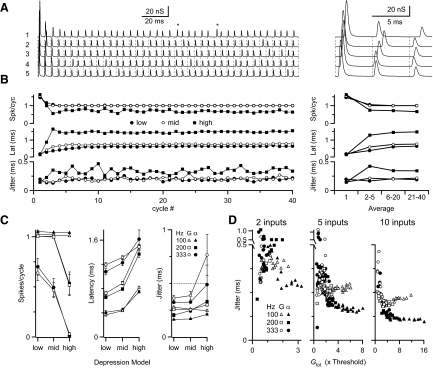FIG. 7.
Effect of depression with multiple synaptic inputs on BC spike timing. A: example dynamic-clamp stimulation paradigm for 5 synaptic inputs firing at 200 Hz, with Gaussian distributed jitter (SD = 0.5 ms), using the middle depression model. Asterisks mark conductances that were somewhat larger, as a result of particularly long recovery times. B: BC responses during train of stimulation as in A, showing the number of spikes per cycle (top), latency (middle), and jitter (bottom). Averages over different periods of the train are shown at right. Pulses 21–40 are the focus for the remainder of this study. C: average results from 5 experiments for spikes per cycle (left), latency (middle), and jitter (right) at different stimulation rates and with input jitter following Gaussian or alpha distributions. The input jitter of 0.5 ms is indicated on the right. D: jitter as a function of the total synaptic conductance relative to threshold (Gtot) for 2 (left), 5 (middle), or 10 (right) inputs. Data are summaries of 5 or 6 experiments for the different conditions.

